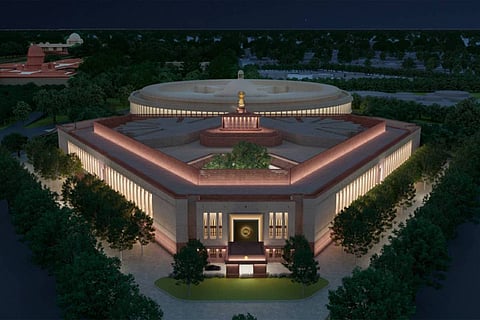

The impending inauguration of the new Parliament building by Prime Minister Narendra Modi on Sunday, May 28, has been mired in controversy. Announcing the date of inauguration, Bharatiya Janata Party (BJP)’s IT cell chief Amit Malviya mentioned that it was also the birth anniversary of Rashtriya Swayamsevak Sangh (RSS) ideologue VD Savarkar. Nineteen Opposition parties have since announced their decision to boycott Sunday’s event, stating that the Prime Minister inaugurating the Parliament, sidelining President Droupadi Murmu, amounts to a grave insult and a direct assault on Indian democracy.
The President is the head of the state, the first citizen of India, and a part of the Union Executive along with the Vice President, Prime Minister, Council of Ministers, and Attorney General of India. The Constitution, in Article 85(1), entrusts the power to summon and prorogue both houses of Parliament and dissolve the Lok Sabha with the President. It is in this context that the Opposition considered the sidelining of the President in the inauguration of the new Parliament an affront to democracy.
The Opposition’s boycott was also prompted by what it called the “undemocratic acts” of the Union government under PM Modi, such as the disqualification of MPs including Congress leader Rahul Gandhi, and the passing of several crucial and far-reaching legislations without debate in the past nine years.
But other controversies around the new Parliament building began much earlier. For lovers of the ‘Lutyens Delhi charm’, the announcement of the Central Vista Redevelopment Project in 2019 caused great disappointment and raised a lot of questions. The project proposed by the Union government included a new Parliament building, Central Secretariat, residences for the Prime Minister and Vice President, conversion of the North and South blocks into museums, renovation of the Rajpath (which was also renamed as Kartavya Path), construction of ministerial offices, and more.
The project has stirred controversies at each stage of its development.
The foundation stone of the new Parliament building was laid in December 2020, when the country was reeling under the economic effects of the COVID-19 pandemic. A budget of Rs 20,000 crore was announced for the project, inviting much public outcry. The government later clarified in May 2021 that the Parliament building itself would cost only around Rs 860 crore.
That the construction of the building was deemed an ‘essential service’ even when all other activities were halted on account of the pandemic’s second wave or the pollution in Delhi also drew flak. Even as citizens lined up in long queues for hospital beds, oxygen cylinders, and crematorium slots, the construction of the new Sansad Bhawan, involving hundreds of workers, went ahead like clockwork. Delhi’s air quality indices plunging to dangerous levels in the winter of 2021 and the Supreme Court imposing a ban on all construction activities on November 24 that year did not prevent the Central Vista construction activity from continuing uninhibited.
When the Lion Capital of Ashoka, or the Sarnath lions, atop the new Parliament building, was unveiled in July 2022, it invited widespread criticism from historians, artists, and politicians. The calm, benign, and dignified composure of the original state emblem was replaced with aggressive, teeth-baring lions for the new Parliament building. Speaking to TheWire, historian Harbans Mukhia asked if the modification meant that the government was signalling the country’s transformation from being a peaceful nation to an aggressive one.
Then in September 2022 came the news of the renaming of Rajpath to Kartavya Path, over a year after the world's largest stadium in Ahmedabad was renamed after PM Modi himself. The move was criticised as politically motivated and ill-intentioned.
The redevelopment of Central Vista requires prior environmental clearance as per the Environment Impact Assessment (EIA) Notification of 2006. However, it was revealed in February 2020 that the Central Public Works Department, which is the project proponent, submitted an application only for the expansion and renovation of the new Parliament building, and not the redevelopment of the entire area between the Rashtrapati Bhavan and the India Gate. This, environmentalists argued, made it possible for the project to take off with reduced environmental scrutiny.
The wide, tree-lined avenues of New Delhi also took a hit with the ambitious redevelopment project. In July 2022, the Union government told Lok Sabha that 2,466 trees were removed for Central Vista. All the trees were meant to be transplanted, and the government also announced that it would ensure the compensatory planting of 10 trees for every transplanted tree. By August 2022, it was known that only 30% of the over 400 transplanted trees had survived. This is despite environmentalists warning that the very idea was scientifically unsound as whole ecosystems cannot be transplanted.
As one part of the Modi regime’s pet project nears inauguration, it calls for a recall of historian Ramachandra Guha’s comparison of the project to the capital building and shifting that the British, and the Mughals before them, engaged in. In an article for the Scroll.in, Guha wrote, “For all his denunciations of British and Mughal rule, Narendra Modi seeks to make his most permanent legacy a crass imitation of what the British and the Mughals did for Delhi.” Calling the project a display of hubris, Guha wrote that the Prime Minister “seeks to perpetuate himself through an architectural reshaping of the very centre of political power.”